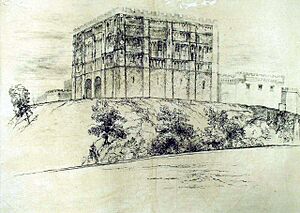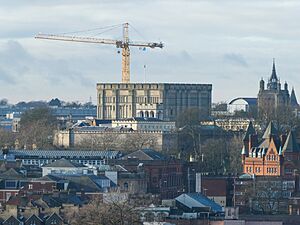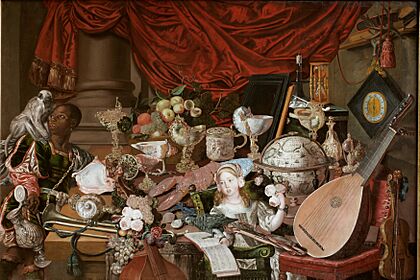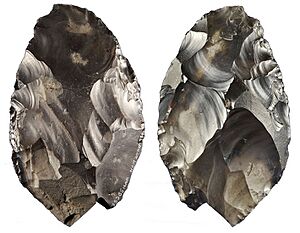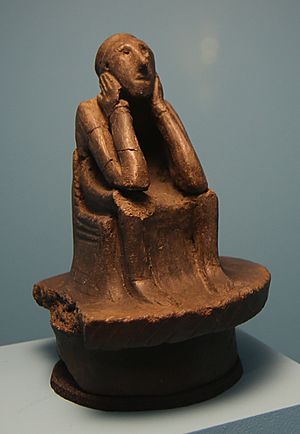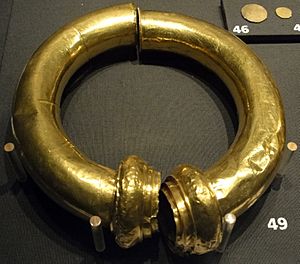Norwich Castle facts for kids
Quick facts for kids Norwich Castle |
|
|---|---|
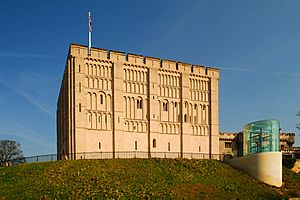
Norwich Castle, March 2009
|
|
| Type | Motte-and-bailey castle |
| Location | Norwich |
| Height | 27 metres (89 ft) |
| Built | 1067 onwards |
| Architectural style(s) | Norman |
| Governing body | Norfolk Museums and Archaeology Service |
|
Listed Building – Grade I
|
|
| Designated | 26 February 1954 |
| Reference no. | 1372724 |
| Lua error in Module:Location_map at line 420: attempt to index field 'wikibase' (a nil value). | |
Norwich Castle is an old royal fortress in the city of Norwich, England. It was built by William the Conqueror after he took over England. For a long time, from 1220 to 1887, the castle was used as a prison.
Today, Norwich Castle is a popular museum and art gallery. It opened its doors in 1894. The museum has many important items from the area, including amazing artworks, ancient discoveries, and cool natural history displays. It's a Grade I listed building, which means it's a very important historical site in the UK. The castle is one of Norwich's top heritage spots and is looked after by the Norfolk Museums Service.
Contents
Castle History: From Fortress to Museum
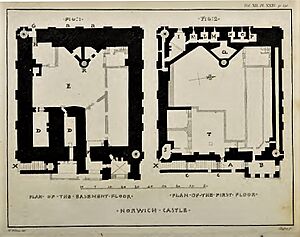
Norwich Castle was started by William the Conqueror between 1066 and 1075. It began as a "motte and bailey" castle, which means it had a big mound (the motte) with a tower on top, and a walled area (the bailey) below. William built it to help control the area of East Anglia.
The first big event at the castle happened in 1075. It was attacked by William's soldiers to stop a rebellion. The siege lasted three months, and the rebels eventually gave up.
Norwich Castle is one of 48 castles mentioned in the Domesday Survey of 1086, which was a huge survey of England. Building the castle meant that many houses had to be taken down. Digs in the 1970s even found that the castle's outer area was built over an old Saxon cemetery! For a long time, Norwich Castle was the only major royal castle in East Anglia.
Around 1100, the castle's mound was made taller, and its surrounding ditch was dug deeper. The stone tower, called the keep, that you see today was built between 1094 and 1121. It had two floors inside, and you entered the upper floor by an outside stone staircase.
In 1173–1174, there was a civil war in England. Norwich Castle was made ready for battle. A powerful earl named Hugh Bigod captured the castle with his soldiers. After the war ended, the castle went back to being controlled by the king.
In 1190, the castle offered safety to Jewish people during a time of violence in East Anglia. Those who couldn't reach the castle were sadly harmed.
The Castle as a Prison: A Long History
Parts of Norwich Castle were used as a prison very early on. It became the main prison for the county of Norfolk. In 1340, a law was passed that gave sheriffs control over prisons inside royal castles, making Norwich Castle the official public prison for the county. The king still owned the castle and appointed someone to look after it.
By the 1700s, the castle looked quite old and worn. Its stone had turned black, and the ditch around it was used for rubbish. A famous prison reformer named John Howard visited the castle several times. He noted that it could hold up to 53 prisoners, including people accused of crimes and those who owed money. He thought the prison needed better conditions, especially for women prisoners.
Between 1789 and 1793, the prison was rebuilt by an architect named John Soane. He changed the inside of the keep to create cells for male prisoners. New buildings were added for women and debtors. This work cost a lot of money, about £15,000. However, some people thought these changes ruined the castle's old look.
Later, the prison was rebuilt again by William Wilkins, the son of an architect who had criticized Soane's work. This new work was finished around 1827 or 1828 and cost even more, about £50,000. Wilkins's design had new wings for prisoners that spread out from a central building. This central building was octagonal and held the jailer's family, a chapel, and meeting rooms. It had views over the prison yards. There were 240 cells in the new wings and 36 cells in the old castle keep. A new building for trials, called the Shirehall, was built nearby. Prisoners could be taken from their cells through a tunnel to the court.
Prisoners at the castle worked making things like mats, sacks, and clothes. In 1862, there were about 134 prisoners each day. The castle stopped being a prison in 1887 when a new prison, HMP Norwich, opened nearby. All the prisoners were moved there on August 2, 1887.
Famous Historical Figures at the Castle
The castle was also a place where important historical events happened, including the final moments of some famous people.
Robert Kett A special plaque at the museum entrance remembers Robert Kett. He was a leader in a peasant uprising called Kett's Rebellion in 1549. Kett and his brother were captured and found guilty. Robert Kett was brought to Norwich Castle and executed on December 7, 1549, from the castle's battlements. A sculpture on the Norwich City Hall shows this event.
James Rush James Rush was a man who was found guilty of a double murder in 1848. His trial and execution caused a lot of interest across the country. He was held at Norwich Castle prison. On April 21, 1849, he was executed in front of many people.
Becoming a Museum and Art Gallery
After it stopped being a prison, the city of Norwich bought the castle to turn it into a museum. Edward Boardman led the changes. The old prison cells inside the keep were removed, and new floors and balconies were put in. Norman-style arches were built to support a new glass roof. The old prison yards became gardens, and the cell blocks were turned into viewing galleries for exhibits.
The museum was officially opened on October 23, 1894, by the Duke and Duchess of York, who later became King George V and Queen Mary.
Castle Architecture: A Norman Masterpiece
G. T. Clark, an expert from the 1800s, called Norwich's great tower "the most highly ornamented keep in England." The castle's main tower, or keep, was originally covered with special stone from Caen, France, over a core of flint. It is about 95 feet (29 meters) by 90 feet (27 meters) and 70 feet (21 meters) high. You entered it on the first floor through an outside building called the Bigod Tower. The outside of the keep is decorated with beautiful blank arches. Only Castle Rising, another castle in Norfolk, has a similar design.
Inside, the keep has been changed a lot over the years, so none of its original medieval rooms remain. However, experts believe it had a complex layout with a kitchen, a chapel, a two-story hall, and many toilets! The original bridge over the inner ditch was replaced around 1825.
Restoring the Keep's Look
The outside of the keep was greatly repaired between 1835 and 1839 by architect Anthony Salvin. A stonemason named James Watson completely refaced the keep with Bath stone, carefully copying its original decorations. Not everyone was happy about this. An artist named Edward Thomas Daniell strongly disagreed with the changes, calling it a "scandalous re-facing." He felt it was important to keep the castle's original, aged look.
Norwich Castle Museum and Art Gallery: Explore and Discover
Today, Norwich Castle is still a museum and art gallery, and it still has many of its first exhibits. The museum's art collection includes old costumes, fabrics, jewelry, glass, ceramics, and silverware. There's also a large display of ceramic teapots! The art galleries show works by the Norwich School of painters from the early 1800s, as well as English watercolors, Dutch landscapes, and modern British paintings from the 1600s to the 1900s. You can also see many works by the Flemish artist Peter Tillemans.
Other parts of the museum explore different times in history, like Boudica and the Romans, and the Anglo-Saxons (including the famous Harford Farm Brooch). There's also a Natural History section with the amazing Fountaine–Neimy butterfly collection. A unique item is the needlework by Lorina Bulwer, made when she was in a workhouse around the turn of the 20th century.
Museum Highlights: Amazing Artifacts
The Paston Treasure This is a famous painting from around 1663. It was likely ordered by the Paston family, who were very wealthy. The artist is unknown, but it was probably a Dutch artist. The painting shows many real objects that the Paston family owned, making it a record of their riches and collections. In 2018, the painting was the main attraction of an exhibition that brought some of the actual objects shown in the painting back together for the first time in almost 300 years!
The Happisburgh Handaxe
This hand axe, made of flint, is a huge discovery! It was found in 2000 along the Norfolk coast at Happisburgh. It's about 500,000 years old, making it one of the oldest handaxes ever found in the UK. This discovery changed what we knew about early humans living in Britain. By studying ancient pollen, archaeologists learned that when this axe was made, the area was a temperate woodland with many different trees.
Roman Cavalry Helmet and Visor Found in the River Wensum in 1947 and 1950, these Roman items date back to the early 200s CE. They are important because they show that Roman soldiers were present in central Norfolk during the later part of the Roman occupation. The helmet is made of gilded bronze and is highly decorated with an eagle's head, beasts, and feathers. The visor mask also has detailed decorations, showing the Roman gods Mars and Victory. These two pieces are not a matching set, but they are both incredible examples of Roman military art.
Spong Man
The unique Anglo-Saxon figurine known as Spong Man was found in 1979 at Spong Hill. It shows a figure sitting on a chair, leaning forward with its head in its hands, and wearing a flat hat. It was probably once on the lid of a pagan burial urn. This is a very special object in Northern Europe because it's the earliest Anglo-Saxon three-dimensional figure ever found. We don't know why it was created or if it represents a god, but it's a great reminder of how much we still have to learn about early religions.
Gold Tubular Torc
Torcs were special neck rings worn by important people in the Iron Age across Europe. They showed a person's status and power. This rare gold torc came from the Snettisham Treasure, found in 1948 at Snettisham. Many other torcs were found buried together, showing that burial rituals were very important to people in Late Iron Age Norfolk.
The Ashwellthorpe Triptych Also known as The Seven Sorrows of Mary, this Flemish altarpiece has strong links to South Norfolk. It was ordered by the Knyvettes family of Ashwellthorpe. Christopher Knyvettes, who was sent to the Netherlands by King Henry VIII in 1512, commissioned this painting. It shows Christopher and his wife kneeling to Mary, mother of Jesus, highlighting their religious devotion and wealth.
Norwich Snapdragon Dragons have always been important in Norwich, especially since medieval times. The Norwich Snapdragon was made to show the city's power and wealth. It was used in parades that celebrated the city's saint and welcomed the new mayor. The Snapdragon at Norwich Castle, called Snap, is the last complete example of these civic dragons. It was built to hold one person inside, with a body made of basketwork painted with gold, red, and green scales.
Norwich River: Afternoon This painting by John Crome is from the Norwich School of Painters. Crome and Robert Ladbrooke started the Norwich Society of Artists in 1803. This group brought together professional painters and drawing teachers who were often inspired by the East Anglian landscape and Dutch painters. This oil painting is considered one of Crome's best works. It shows the River Wensum near where the artist lived in Norwich.
Norfolk Regiment First World War Casualty Book This book is a unique record of the Norfolk Regiment's involvement in the First World War. It lists details for over 15,000 soldiers from 1914 to 1919, including their names, service numbers, battalions, and health information. It also records those who died in action.
Stained-Glass Roundel: December This stained-glass roundel, showing December, is a rare example of English medieval art from the Norwich School of stained-glass. It shows influences from Flanders and might have been made by one of the "Norwich Strangers," who were immigrants from the Low Countries in the 1500s. It was likely made for Major Thomas Pykerell's house. Originally, there would have been twelve roundels, each showing a "Labour of The Month," which was a popular theme in Norwich. This particular roundel shows the King of Christmas. Only four of the original twelve roundels still exist today.
See also
 In Spanish: Castillo de Norwich para niños
In Spanish: Castillo de Norwich para niños


